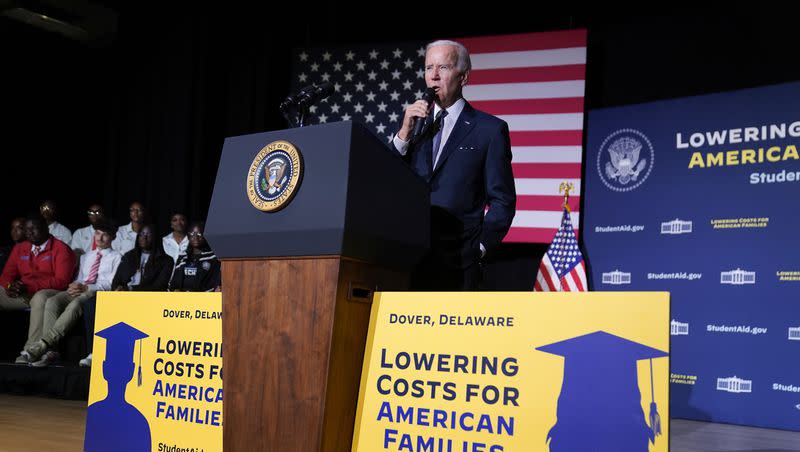Opinion: Why Biden’s Plan B for student loan forgiveness won’t work

- Oops!Something went wrong.Please try again later.
Parents tend not to be impressed when a teenager, whose idea was rejected because it violated a rule, comes back with a Plan B that still violates that rule.
Granted, I may be stretching a point beyond its rhetorical tensile strength to compare the oldest president in history to a teenager, or six of nine Supreme Court justices — who struck down President Joe Biden’s loan forgiveness program — to parents. But it’s no stretch to assume the court’s conservative majority wouldn’t be any more impressed with Biden’s Plan B for tuition loan forgiveness than it was with Plan A.
Plan B still ignores the rules laid out by the nation’s founders. Congress has to be the one making a decision as large as forgiving student loans — a move that would cost taxpayers $400 billion. Presidents aren’t dictators.
Or, to quote former Democratic House Speaker Nancy Pelosi, as the Supreme Court’s majority opinion did: “People think that the president of the United States has the power for debt forgiveness. He does not. He can postpone. He can delay. But he does not have that power. That has to be an act of Congress.”
Maybe it’s time, finally, to acknowledge the real problem here, which is that college tuition has become far too expensive.
A little more than a month from now, freshmen will show up on campuses nationwide. Many of them will need loans to stay there. Perhaps many will hope they never have to repay these. That won’t make college any cheaper, especially if those hopes come true. That would raise tuition even higher, while the rest of us, including many American adults who never got a degree, will have to pay.
The White House says a part of Plan B would be to create a one-year “on ramp” for borrowers who will have to restart monthly payments on their loans in October. If they miss payments, they would not be considered delinquent. They wouldn’t be reported to credit bureaus or debt collectors.
Borrowers with undergraduate loans would have to pay only 5% of their discretionary income per month, and the administration is raising what it considers to be nondiscretionary income to 225% of the federal poverty level, or about $15 per hour. Loans with balances under $12,000 would be forgiven after 10 years, instead of the current 20, and no one would have to pay beyond 20 years. Borrowers wouldn’t have to make up unpaid monthly interest.
Related
Supreme Court rules 6-3 to reject Biden’s student loan debt forgiveness plan
Why this community college teacher champions student loan forgiveness
Sens. Mike Lee and Mitt Romney support decision to overturn President Biden’s student loan program
Writing for the conservative reason.com, Eric Boehm said, “The consequences of capping monthly payments and also capping the length of time a loan can be in repayment should be fairly obvious: A lot of loans will never get paid back in full.”
He quotes a Brookings Institution study that examined similar parts of Plan A and concluded “Biden’s income-based repayment plan will result in ‘tuition inflation’ and ‘increased borrowing,’ particularly by students in pursuit of ‘low value, low earning’ degrees.”
When you remove the cost of a college education a step from consumers’ pocketbooks, there is no longer any downward pressure on costs. The school gets its money as soon as the loan is approved, and the government is in charge of collecting payments, which it may, under these plans, do only halfheartedly.
Here are some better plans: Start restricting the federal loans available to a school that raises tuition beyond the Consumer Price Index of inflation each year. Threaten the tax-exempt status of schools unless they bring certain costs down. Loans could be used as downward pressures on costs, rather than as a tool for worry-free cost increases. Those were ideas suggested a few years ago by Forbes contributor Roger Ma.
If the nation could bring down the actual cost of a college education, more people of all income levels would have access, and taxpayers wouldn’t have to pick up the tab for loans so high students can’t repay.
Not that this is really such a big problem. The three-year student loan default rate was 2.3% in 2019, according to the Department of Education. It has been declining steadily.
Some in the media like to focus on the hardship cases — the people who took out loans but, for one reason or another beyond their control, couldn’t earn a degree. Or they find a graduate with a low-paying job, whose payments are an unreasonable burden.
These are a minority. The Wharton School of Business analyzed Biden’s Plan A and determined that between 69% and 73% of its benefits would go to households in the top 60% of earners nationwide. Engineers and math majors would get their loans forgiven, too. People with college degrees tend to earn more than everyone else.
So, help the hardship cases and let the others pay their obligations.
Unfortunately, in politics, as with petulant teenagers, facts like that don’t often matter.

